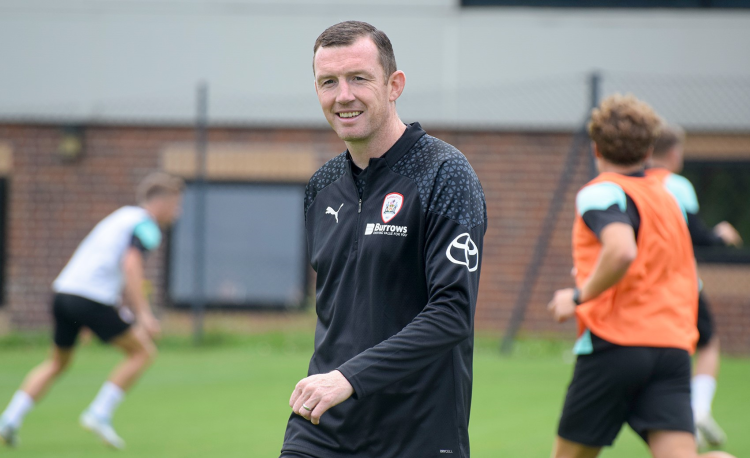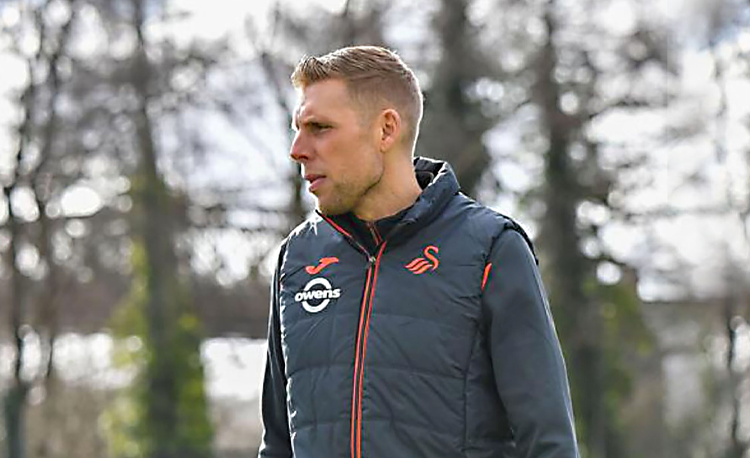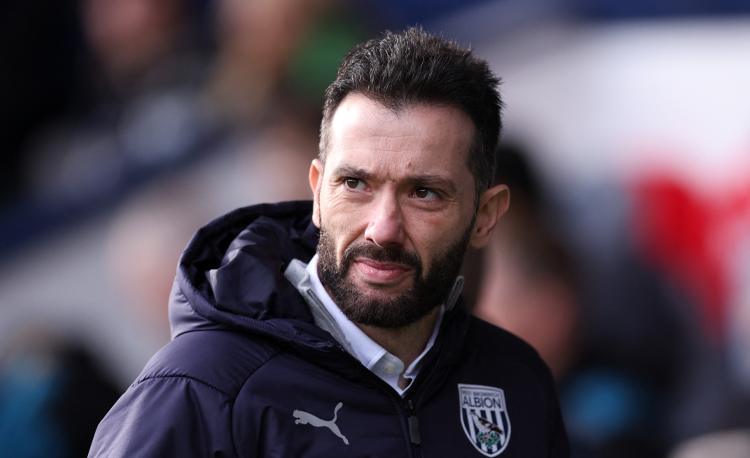You are viewing 1 of your 1 free articles
Unlocking the wing backs
This session is designed to teach teams to utilise the wing backs in build-up play and attack.
| Area | Up to full pitch |
| Equipment | Balls, bibs, cones, 4 mini goals, 2 full size goals |
| No. of Players | Up to 18 players + 2 goalkeepers |
| Session Time |
Practice 1: 10mins Practice 2: 15mins |
This session is designed to teach teams to utilise the wing backs in build-up play and attack. This exercise should show the players that by getting the wing backs in possession it gives the opposition decisions to make on how to defend the width of the pitch.
This session is very specific to teams that want to play with width and, more specifically, with wing backs or aggressive full backs. As the session progresses, it should encourage attacking situations where the team in possession can create overloads and quality attacking moments in the final third.
This would be a session I would use regularly when trying to bed down our core principles, or at any point in time during the season when I feel the need to reinforce our key principles of using width in possession. These exercises can be useful for coaching build-up play, switching the point of attack in transition, and attacking the final third.
“This session is very specific to teams that want to play with width and, more specifically, with wing backs or aggressive full backs”
PRACTICE 1
We set up a playing area of 40x30 yards with a pair of small goals at each end. A goalkeeper is positioned at each end and should slide across to protect both of the mini goals at that end.
We’re using 17 outfield players split into a red team of seven and a blue team of seven, plus three yellow floaters who play for the team in possession. One floater is positioned in the main area while the other two are wing backs positioned on each side, as shown.
One of the goalkeepers starts with the ball and plays it out to the possession team, who are supported in possession by the central floater and the two wing back floaters.
The possession team gets one point for making 10 consecutive passes, as shown [1a]...
[1a]
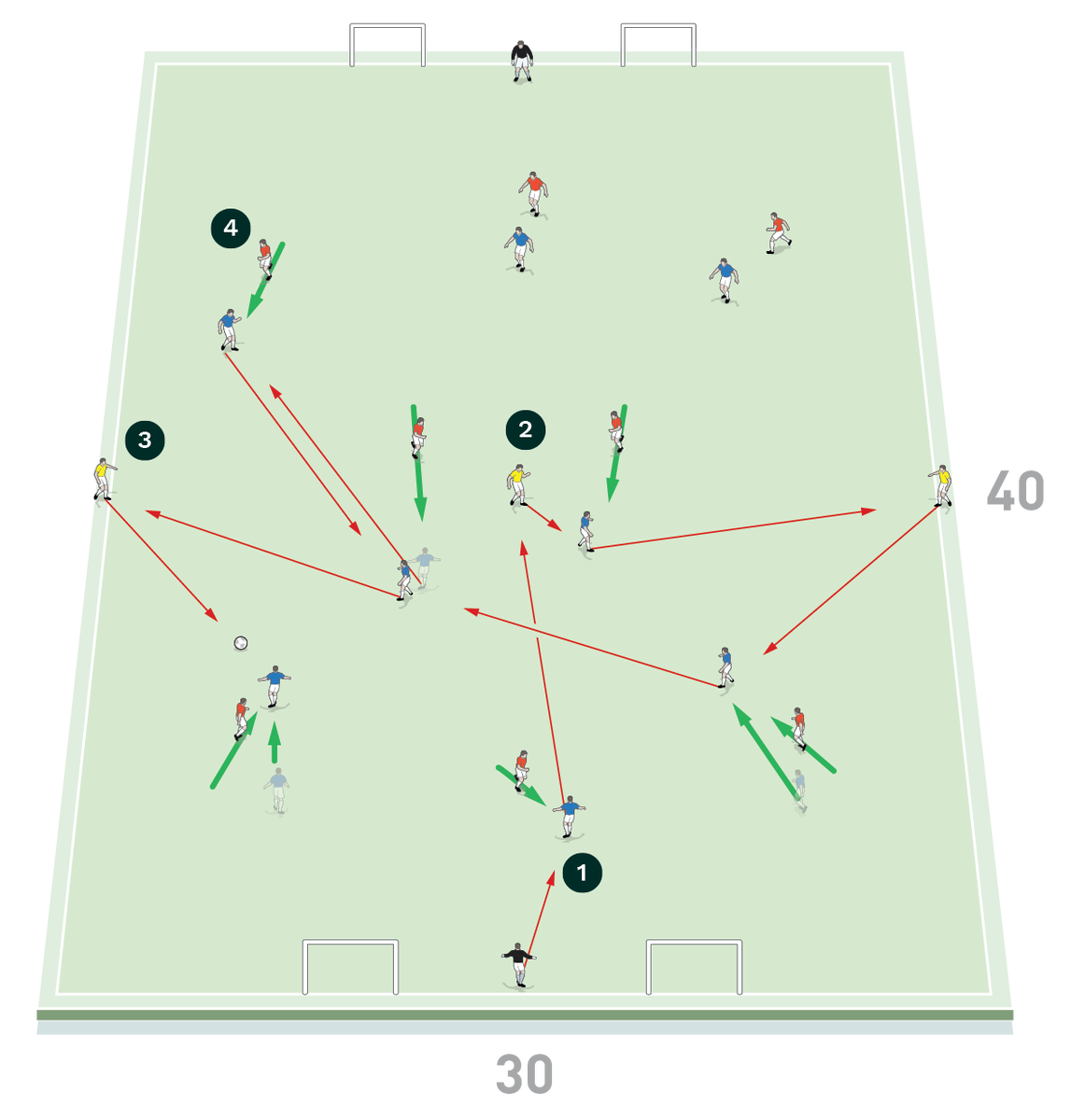
- The goalkeeper starts with the ball and plays it to the blue team, who look to string 10 consecutive passes together to score one point or finish in a goal to score two points
- The yellow floaters play for the team in possession but they are restricted to two touches
- The two yellow floaters on the outside are wing backs and they can’t be tackled
- The reds press and try to win possession
...and two points for scoring in one of the mini goals, as shown [1b].
[1b]
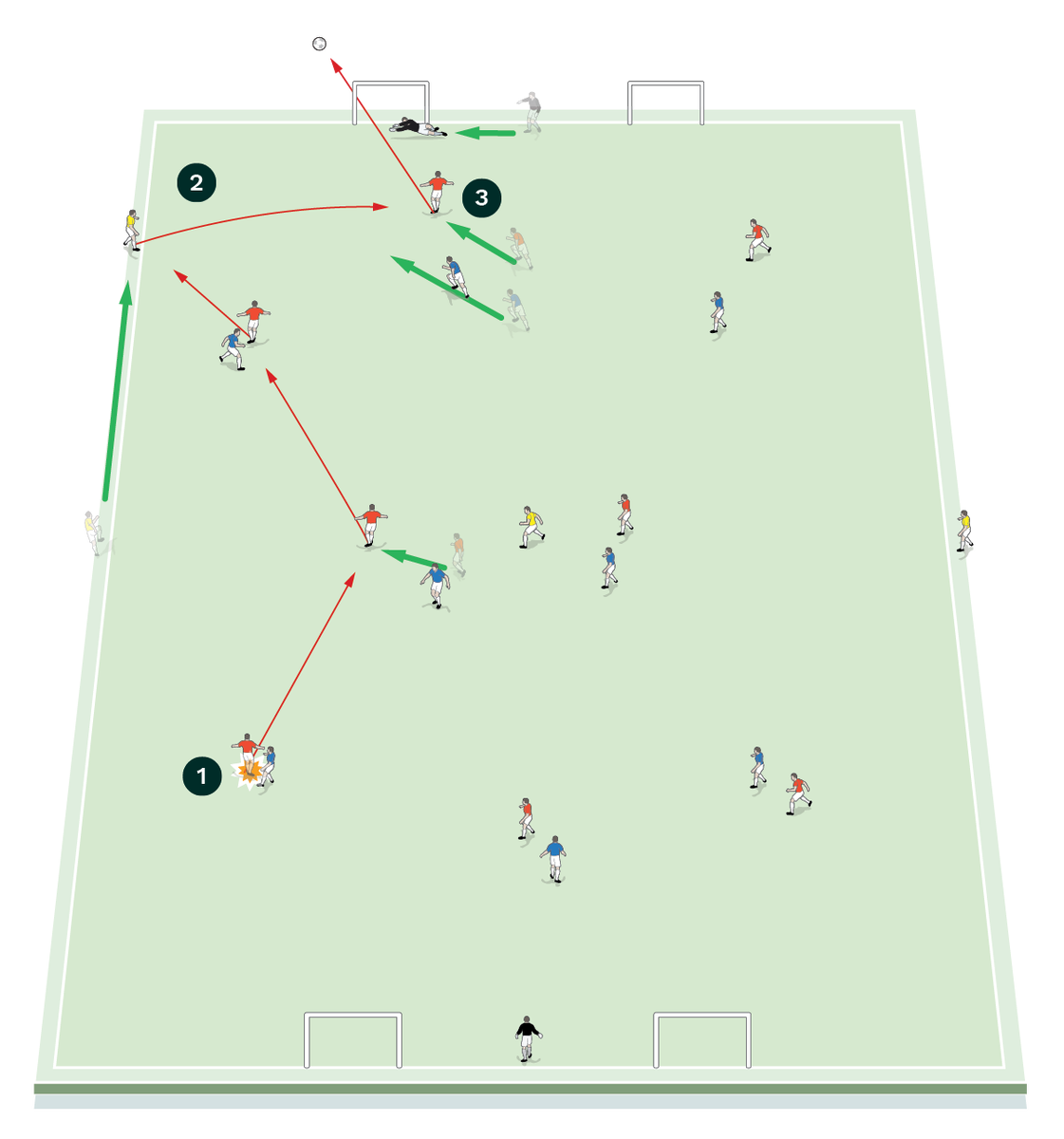
- The reds press and win the ball back and become the new possession team
- The reds play the ball to the floating wing back, who crosses
- The reds get two points for scoring in the goal
The yellow floaters are restricted to two touches and the wing back floaters cannot be tackled to begin with.
“We need to make sure players are making angles to receive when the wing backs are in possession”
One of the key objectives is to encourage the team on the ball to utilise the extra floating players and retain possession.
Due to the nature of the scoring, the opposition players must regain possession to stop the possession team winning points.
As the out-of-possession team begins to press, spaces should appear that create decisions for the team in possession, challenging them to decide when to try and go forward to score in the mini goals.
We need to make sure players are making angles to receive when the wing backs are in possession. There should be forward runs to stretch the opposition defence. There should always be depth provided to allow the team to recycle possession and there should be a central option supporting inside the wing backs who is also ready to receive. If all these options are provided, it will be difficult for the opposition to defensively cover all passing lanes.
We play four blocks of three minutes.
PRACTICE 2
We set up a playing area of 80x66 yards with a full size goal and goalkeeper at each end. A five-yard wide channel is created on each flank and a halfway line is marked out.
We’re using 18 outfield players, split into two teams of nine including goalkeepers, plus two floating wing backs, one in each wide channel. The floaters are limited to two touches in the build-up half of the pitch but are all-in if they receive the ball in the attacking half. The neutrals can be tackled in the wide zone only after they have received the ball.
Each team of nine starts in their own defensive half and play begins with a pass out from the keeper. The possession team builds up play using the support of the neutral wing backs, giving the team an attacking overload, as shown [2a].
[2a]

- Play starts and restarts with a pass out from the keeper. The aim for the possession team is to build play and score in the goal at the other end
- The possession team use the support of the neutral wing backs, giving the team an attacking overload
- The neutral wing backs are limited to two touches in the build-up half of the pitch but are all-in if they receive the ball in the attacking half
The aim is to score in the goal the team are attacking and the conditions are designed to encourage the team to utilise the full width of the pitch and to create defensive issues for their opponents.
If the opposition team wins possession of the ball, they should counter-attack using the support of the neutral wing backs, as shown [2b], but the same conditions apply.
[2b]
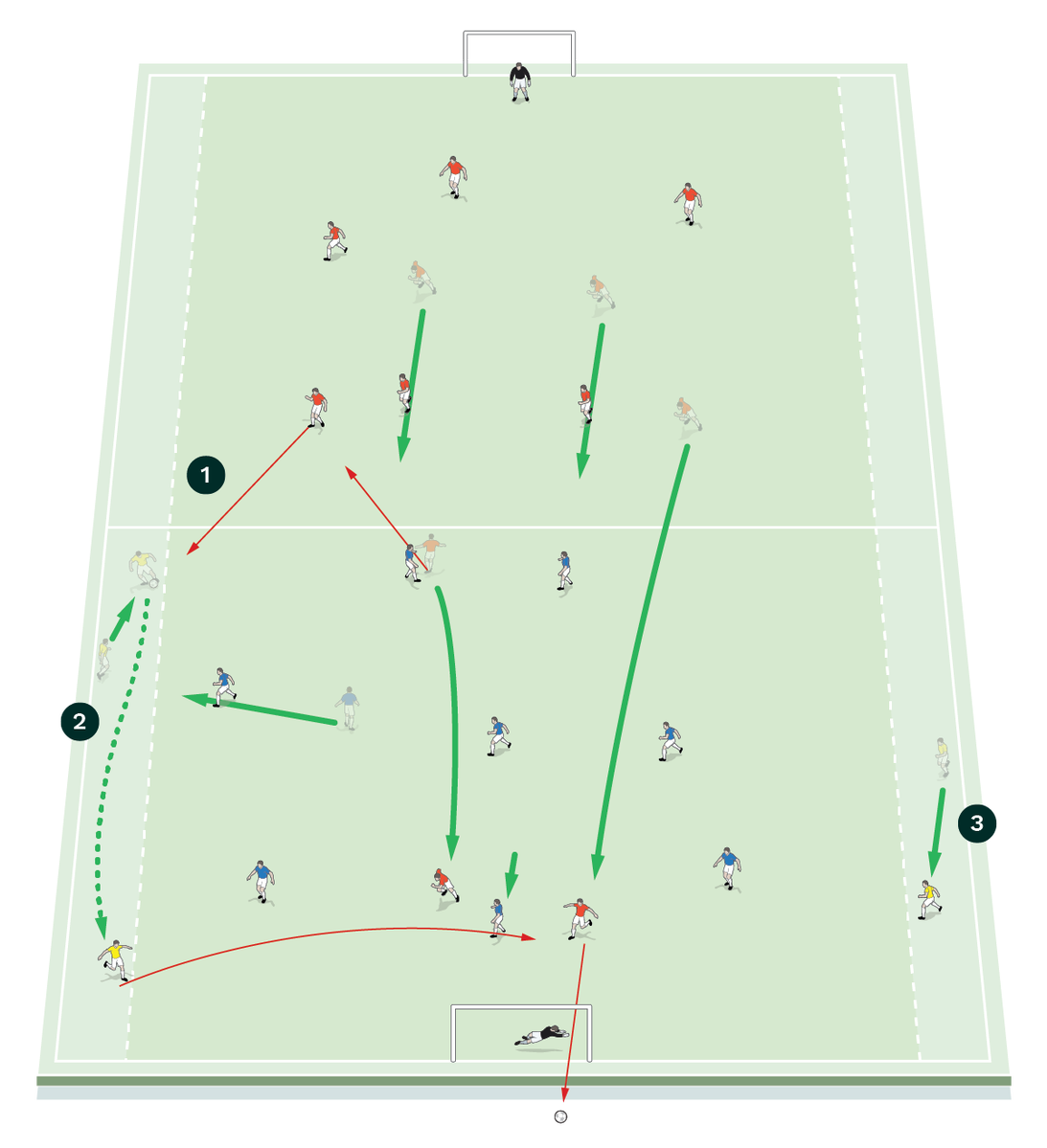
- If the opposition team wins the ball, they should counter-attack using the support of the neutral wing backs
- The wing backs must make sure they are constantly adjusting their starting position to be in a good position to receive the ball
- In the attacking half, the wing backs are allowed unlimited touches of the ball
“Make sure the possession team uses its overload by bringing the neutral wing backs into play”
The progression from the first exercise to the second exercise is a good way of seeing how the players are taking the information onboard and putting it into action in a game situation.
We play two blocks of seven minutes.
COACHING POINTS
What are the key things to look out for?
From a team perspective the key coaching point is to make sure the possession team uses its overload by bringing the neutrals into play. The wing backs must make sure they are constantly adjusting their starting position to be in a position to receive the ball. Once they receive, their first touch is key to allowing the team to progress the ball forwards.
Attacking triggers are important when the wing backs receive in the final third. We want to see the strikers and midfielders making movements in the box to disorganise the opposition defence.
What are the typical mistakes players might make and how do I avoid them?
In Practice 1, players must recognise when to attack the mini goals and when to maintain possession, as the activity is aimed at improving this type of decision making.
In Practice 2, the main mistake is not bringing the neutral players in to play, because making use of the extra player is key to the success of the activity. The neutrals are also often guilty of not making themselves available by failing to work up and down the wide zone. It is important for the neutral wing backs to make themselves an option.
Related Files
Editor's Picks
Using the goalkeeper in build-up play
Pressing principles
Intensive boxes drill with goals
Penetrating the final third
Creating and finishing
My philosophy
Pressing initiation
Compact team movement
Defensive organisation
Coaches' Testimonials

Alan Pardew

Arsène Wenger

Brendan Rodgers

Carlos Carvalhal

José Mourinho

Jürgen Klopp

Pep Guardiola

Roy Hodgson

Sir Alex Ferguson

Steven Gerrard
Coaches' Testimonials

Gerald Kearney, Downtown Las Vegas Soccer Club

Paul Butler, Florida, USA

Rick Shields, Springboro, USA

Tony Green, Pierrefonds Titans, Quebec, Canada
Join the world's leading coaches and managers and discover for yourself one of the best kept secrets in coaching. No other training tool on the planet is written or read by the calibre of names you’ll find in Elite Soccer.
In a recent survey 92% of subscribers said Elite Soccer makes them more confident, 89% said it makes them a more effective coach and 91% said it makes them more inspired.
Get Monthly Inspiration
All the latest techniques and approaches
Since 2010 Elite Soccer has given subscribers exclusive insight into the training ground practices of the world’s best coaches. Published in partnership with the League Managers Association we have unparalleled access to the leading lights in the English leagues, as well as a host of international managers.
Elite Soccer exclusively features sessions written by the coaches themselves. There are no observed sessions and no sessions “in the style of”, just first-hand advice delivered direct to you from the coach.
